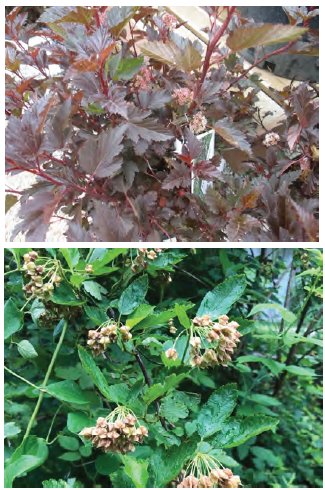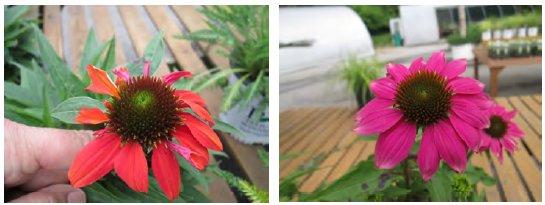AgEBB-MU CAFNR Extension
Green Horizons
Volume 25, Number 3
Fall 2021
 |
Natives, Cultivars, and "Nativars"
The natural world supports tremendous genetic diversity within and among plant species. This genetic diversity developed over millions of years in response to growing conditions in ecosystems and natural habitats including geology, soil types, climate, and rainfall, as well as animal/insect herbivory and plant diseases.
Straight native plant species are plants that occur in the wild-as described above-and reproduce without intervention from people. Their diversity of genes gives them more adaptability (or survival insurance) in the face of disease, growing conditions, climate change, or other factors. Also, because insects and other invertebrates-as well as other animals-have co-evolved with native plants for thousands of years, the nutritional value of foliage, pollen, nectar, fruits, and seeds of straight native species is known.
The Grow Native! program recognizes that some or perhaps many "nativars" (a cultivar or genetic variant of a straight native species) may have as high an ecological value as native species, but in many cases this is conjecture, and is not absolute. In fact, there are few studies comparing the nutritional value of straight native species to cultivars/nativars. Whether studied or not, human-based selection of plant and animal species can have unintended negative consequences. Therefore, the Grow Native! program promotes native species for their known and documented ecological value.
Please see the Grow Native! Native Plant Database for a searchable database of 300+ native plants and other Grow Native! native plant resources. All plants referenced on Grow Native! website pages are native plants, not cultivars or nativars.
Many plants in the mainstream horticulture trade are promoted and labeled as "native" when in many cases, these plants are not straight native species, but rather "nativars." Be sure to check the websites of such brands of plant products and ask questions before you purchase plants.
The Grow Native! program offers Grow Native! plant tags for more than 200 species to its professional members who propagate and/or sell native plants. These tags indicate that these plants are straight native species, not cultivars or nativars.
It is important to note that-without protected original habitats where native plants reproduce in the wild-there would be no genetically diverse, native seed available for the native plant industry. Grow Native! encourages native landscaping enthusiasts to support efforts to protect original native plant habitats, including original prairie remnants, glades, wetlands, riparian areas, woodlands, and forests.
 |
| Some nativars bred for speficic traits such as the "Summer Wine" ninebark nativar with dark foliage (top), may not be as nutritious as the foliage of the straight species of ninebark, Physocarpus opulifolius (green foliage). Photo of nativar by Sue Leahy. Photo of straight species by Carol Davit. |
 |
| Photo of native species by Mervin Wallace. |
What are native plants, cultivars, and nativars?
Native plant: A plant that originally occurs within a region as the result of natural processes rather than human intervention. In the lower Midwest (Missouri and surrounding states), native plants have existed since prior to the time of widespread Euro-American settlement a little more than 200 years ago.
Cultivar: A plant selected for a certain trait, for example, flower color, foliage color, fruit color, shape, size, pest resistance, growth habit, disease resistance, longer bloom times, or stronger stems. Cultivars can be derived from non-native plants or native ones. Cultivars derived from native plants are often called "nativars." Cultivars can have sterile flowers and produce no seeds. Most cultivars are created by cloning (asexual reproduction, such as with plant cuttings), in which clones of the parent plant are produced. Types of cultivars include seedlings within one species (most common), strains, and hybrids (see definitions in glossary below) as well as via genetic manipulation at the cellular level in a laboratory, such as Roundup-ready corn and soybeans.
For example, within a population of a straight native plant species in the wild, there may be some individuals that are more compact in stature than others. A cutting might be made of one of those compact individuals, and that plant propagated asexually to preserve the compact structure gene. However, individuals in that same population with a taller structure might also have produced more nectar for butteries than the compact individuals, but cuttings are not taken of those individuals. Having some "compact structure" cultivars on the marketplace may not be a problem. However, if that cultivar becomes dominant in the marketplace and in landscaping, the "higher nectar" genetic traits of this plant disappear from plants in cultivation.
Some cultivars, however, are named strains of native plants found in nature and are seed grown. For example, eastern redbud (Cercis canadensis) 'Columbus strain', is a cultivar valued for its cold hardiness.
Nativar: A cultivar of a native plant, the result of human selection for a specfic plant trait(s). Some nativars can have sterile fowers and seeds.
Why are native plants important?
In the lower Midwest (Missouri and surrounding states), all plants were native prior to the time of widespread Euro-American settlement a little more than 200 years ago. While the activities of indigenous people did affect the region's ecosystems, it wasn't until the mid-1800s that large-scale habitat alteration and the introduction of nonnative plants began to significantly change the natural landscape of the lower Midwest.
Native plant species in the lower Midwest have evolved here over millennia and are best adapted to the region's climate and soil conditions. Even more importantly, native plants have co-evolved with native insect species and provide food resources for thousands of species of insects and invertebrates that in turn provide food for native birds and other animals. For example, native plants provide nectar, pollen, foliage, and seeds to feed native insects and other wildlife. Most insects that eat plants can develop only on specific native plant species (called host plants). Almost all native birds (including turkey and quail)-regardless of what they eat as an adult-feed their young insects for protein. Native bees and other pollinating insects provide pollination services for agricultural crops such as fruits and vegetables and thus, they are a vital link in providing food for human consumption. They also pollinate 90% of all fowering plants and thus are essential to diverse ecosystems.
Native plants are adapted to the climate and soil conditions where they naturally occur. They do not require fertilizers or pesticides and need considerably less water than many non-native plants. Native plants have functioning reproductive structures and viable seed. Non-natives, including nativars and cultivars, are typically bred for specic desired traits. In the process of selecting for specific traits, other traits can be deselected and disappear from a plant in the nursery trade, which can lead to the loss of genetic diversity in plants available for purchase for landscaping or other purposes.
The complex root systems of native plants contribute to healthy soil, and reduce and filter water runoff, which protects streams. Choosing native plants for landscaping beauties yards and other spaces, supports nature's web of life, manages storm water, and stores carbon. Prairie grasses and wildflowers store carbon in their roots (and in surrounding soil), and in many situations do so much more effectively than trees and wooded landscapes. It is important to note that, without protected original habitats where native plants reproduce without interference from people, there would be no genetically diverse, native seed available for the native plant industry. Grow Native! encourages native landscaping enthusiasts to support efforts to protect original native plant habitats, including original prairie remnants, glades, wetlands, woodlands and forests.
Are cultivars/nativars good or bad for pollinators and wildlife?
The short answer, in the words of entomologist Dr. Doug Tallamy, who wrote Bringing Nature Home, and Nature's Best Hope, is "It depends."
This is a complex question and, as Tallamy notes, there is not a straightforward answer. With cultivars/nativars, humans select for certain plant traits over others; the traits that are selected against (that are therefore absent in the plant) may or may not have ecological consequences.
In some cases, cultivars/nativars do not provide food sources for leaf-eating and pollinating insects, as their native counterparts do. Tallamy has noted that nativars bred for brown or other dark foliage may not provide the same nutritive value for leaf-eating insects that depend on specific native plants for food. If a gardening goal is to support specific insects that depend on specific host plants to survive, these cultivars should be avoided.
 |
| 'Sombrero Hot Coral' (left) and 'PowWow Wild Berry' (right) purple cone ower nativars. Photos by Sue Leahy. |
Many nativars have been bred to have more petals and much reduced oral reproductive structures than their native counterparts, with less or perhaps no nectar or pollen for pollinating insects, or seeds for songbirds. Insects may be attracted to plants such as this, and use energy traveling to alight on the flowers of this cultivar, when in fact its flowers may offer little or no food sources. Other nativars are bred for petal color that is widely divergent from the color of the flower in the native species and may confuse the insects and other wildlife that depend on them.
These nativars of purple cone flower have different petal colors than the native species (Echinaea purpurea), the effects of which are unknown to pollinating insects. See earlier photo of native species by Mervin Wallace.
In other cases, nativars may provide as much food and nutrition to insects and other wildlife as native species do or more. For example, a local ecotype of redbud from Wisconsin became a named cultivar called the "Columbus strain" redbud. It is cold hardy and has been planted beyond redbud's typical range in Illinois, Wisconsin, and Minnesota. This redbud provides nectar and pollen to pollinating insects, and its foliage is likely food for insects as well. However, it is also true that the proliferation of the use of nativars like this-throughout the native range of the native species of redbud-can result in a loss of genetic diversity of redbuds on the landscape, which may have negative consequences for nature's food web. This is underscored by Tallamy again as he asserts, "It's not the presence of cultivars, but the absence of natives that's a problem."
Research and observational studies on the nutritional value of cultivars/nativars to pollinating and foliage-eating insects is scant but ongoing, and as more results of research become available, the Grow Native! program will share the information on this web page. Please see the Grow Native! Native Plant Database for a searchable database of 300+ native plants and other Grow Native! native plant resources. The Grow Native! program promotes the use of native plants. All plants referenced on other Grow Native! website pages are native plants, not cultivars or nativars.
Glossary
Biodiversity: The variety of life forms found within an ecosystem. Biodiversity is increased by genetic change and evolutionary
Dioecious: Describes a plant species in which male and female flowers are on separate individuals (e.g., hollies, persimmons)
Exotic: A plant not native to the continent on which it is now found. "Alien" and "non-native" are synonyms.
Genetic diversity: Variety of genetic characteristics within a species and is a factor enabling natural selection to occur; allows populations to adapt to environmental changes.
Noxious weed: A plant that directly or indirectly causes damage to crops, livestock,poultry, irrigation, navigation, natural resources, public health or the environment.
